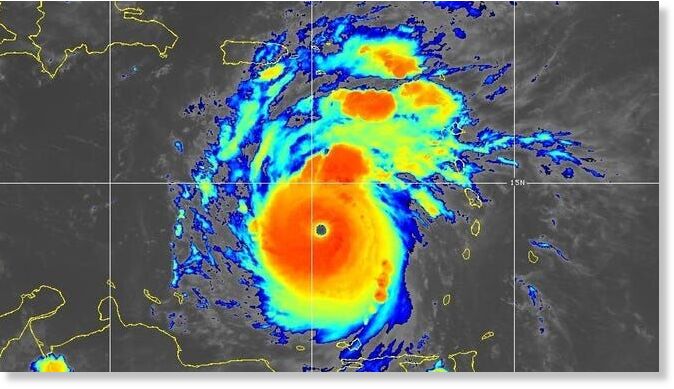
© NOAAHurricane Beryl on July 1, 2024.
Hurricane Beryl is heading towards Jamaica after at least six people were killed when the storm tore through the Caribbean islands on Monday.
The storm was upgraded to Category 5 overnight - the highest level of hurricane warning after
winds were recorded at 165mph.After making landfall on the Grenadines, the storm left behind a path of "immense destruction, pain (and) suffering", said Prime Minister Ralph Gonsalves.
Three people were reported to have died in Grenada and Carriacou and another in St. Vincent and the Grenadines, officials said.
Two other deaths were reported in northern Venezuela, where five people are missing.
One of those killed in Grenada died after a tree fell on a house, according to Kerryne James, minister of climate resilience, environment, and renewable energy.
Beryl is expected to hit Jamaica early on Wednesday, bringing life-threatening winds and a storm surge that could be almost two and a half metres above typical tide levels.
Rainfall of four to eight inches is also expected, with
localised amounts of up to 12 inches, which may cause flash flooding.Residents in flood-prone areas have been warned to prepare for evacuation.
Winds brought communications down across most of the region on Monday, with hospitals left without power and homes without water.
As the storm swept across the other Caribbean islands, streets were strewn with shoes, trees, downed power lines, and other debris.
Banana trees were snapped in half and livestock were killed, with homes made of tin and plywood tilting precariously nearby.
"The situation is grim," Grenadian Prime Minister Dickon Mitchell said.
"There is no power, and there is almost complete destruction of homes and buildings on the island. The roads are not passable, and in many instances they are cut off because of the large quantity of debris strewn all over the streets."
Beryl's rapidly intensifying strength and early arrival are rare for the Atlantic hurricane season and are a troubling indicator that this season will be far from normal.
The storm has already shattered numerous records. On Sunday it became the earliest major hurricane - defined as one that is Category 3 or higher - in the Atlantic in 58 years and the only one to reach Category 4 status in the month of June.The hurricane was able to churn to life because the ocean is as warm now as it would normally be at the peak of hurricane season, said Jim Kossin, a hurricane expert and science advisor at the nonprofit First Street Foundation.
"Hurricanes don't know what month it is, they only know what their ambient environment is," Mr Kossin said. "Beryl is breaking records for the month of June because Beryl thinks it's September."
Mr Kossin added the ocean heat fueling Beryl's unprecedented strengthening "certainly have a human fingerprint on them".
The National Oceanic and Atmospheric Administration predicts the 2024 hurricane season is likely to be well above average, with between 17 and 25 named storms. The forecast calls for as many as 13 hurricanes and four major hurricanes.
An average Atlantic hurricane season produces 14 named storms, seven of them hurricanes and three major hurricanes.

Reader Comments